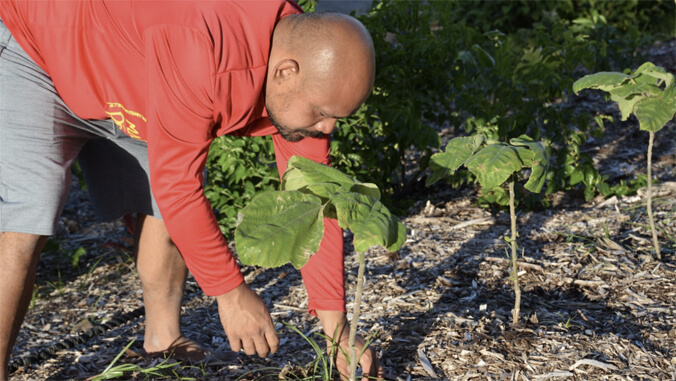
This column by University of Hawaiʻi Maui College Chancellor Lui Hokoana was published by The Maui News on January 27, 2024.
Five years ago, the third-acre plot of land at the mauka end of our campus’s main parking lot was filled with debris and invasive species. But as I walked through that place with Nicolette van der Lee, our Program Manager of University of Hawaiʻi Community Colleges, and UH student Dustin Palos, we saw its potential — as a mini-model for agroforestry, regenerative agriculture, and indigenous knowledge through conservation and security initiatives. Like anything worthwhile, it took laulima — many hands — to bring that early vision to life. It was named the Kauluwehi Garden and now it is definitely, as its name suggests, adorned with greenery.
After last August’s devastating wildfires, the garden was established as a “puʻuhonua,” — a place of refuge — with a new focus. “We switched from working with plants like kalo, ʻuala, and ʻōlena to concentrate on how best to respond to post-fire restoration,” explains Palos, the UH student who took the lead in transforming Kauluwehi into a biocultural garden. It also became the research project for his Natural Resources and Environmental Management advanced degree thesis. “It is filled with some of the most resilient and commonly native trees,” he says. “There are also at least 26 types of endemic plants, five indigenous plants, and 30 food or food/medicinal purpose trees. We hope to inspire and change the vision of what future communities could look like based on the model we have created here.”
“One of our goals is that Kauluwehi be the first in an ‘archipelago’ of similar biocultural refuges all over Maui County,” says van der Lee. “Thousands of plants have already been donated to support Lahaina and other sites throughout Maui Nui. Now that we have new funding, we’re looking to greatly expand our propagation and replanting efforts.”
The funding to which Nicolette refers is a newly awarded $300,000 USDA National Institute of Food and Agriculture (NIFA) grant for a project entitled Puʻuhonua Kauluwehi: Maui Wildfire Rapid Response Strategies for Agroecosystems Resilience, Food Security and Community Well-Being. It will host immersive, ʻāina-based learning experiences for local participants including youth and adults from underserved and displaced communities. The goals are to effectively increase community stakeholders’ access to environmental, human health, and socioeconomic benefits, broaden youth and adult engagement and education in agroecosystem planning and restoration, increase local capacity for agroforestry restoration across Hawaiʻi, and enhance awareness of the best practices of biocultural refuges to improve resilience to climate change and extreme events.
We plan to engage with students in the community in three ways. First, we’re training Lahainaluna students and UHMC Data Science students to be “ʻĀina Data Stewards.” They’ll map the different plants and trees in Kauluwehi and then partner with Maui Nui Botanical Garden to map its site. “We’re excited to provide a place that students can work mapping an extensive native plant collection, some of which has been in place for nearly 50 years,” says Maui Nui Botanical Garden Executive Director Tamara Sherrill. “The work they do could help us in many ways, from outreach to collections management. And the project also supports our long-term vision of cultivating widespread preservation, conservation, and integration of Hawaiian plans throughout Maui Nui.”
Second, students designated as “ʻĀina Data Interns” will lead the Data Stewards teams and work on designing and developing websites for the maps and the data sets. Finally, we’ll recruit “Kauluwehi Community Stewards,” 250 youth and adults to participate monthly throughout the year to propagate native plants, attend art workshops, become involved in community health and wellness initiatives, and more.
Clay Trauernicht is Extension Specialist in Ecosystems and Fire, Department of Natural Resources and Environmental Management at UH Mānoa and the advisor on Dustin Palos’ project. “It’s no secret that the lands around Lahaina and elsewhere in Hawaiʻi are no longer the places of abundance they once were. Places like Kauluwehi are a window into what these landscapes could look like,” he says. “Land care starts with people and the Puʻuhonua Kauluwehi project will connect people to the type of work required to restore both cultural landscapes and native ecosystems.”
It will take a lot of work by a lot of people who care a lot. We’re happy and honored that the work starts with us.
For complete information on the Puʻuhonua Kauluwehi Project including ways you can help, please visit https://maui.hawaii.edu/kauluwehi/. For complete information about UH Maui College, please visit http://maui.hawaii.edu/
*Dr. Lui K. Hokoana is Chancellor of the University of Hawaiʻi Maui College. Kaʻana Manaʻo, which means “sharing thoughts,” is scheduled to appear on the fourth Sunday of each month. It is prepared with assistance from UH Maui College staff and is intended to provide the community of Maui County information about opportunities available through the college at its Kahului campus and its education centers.

